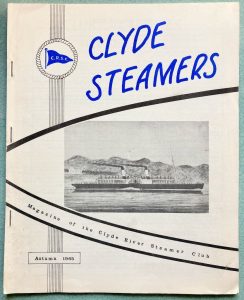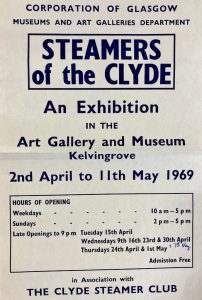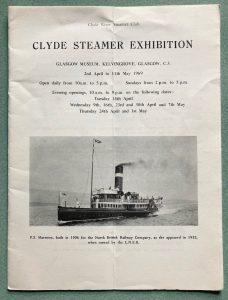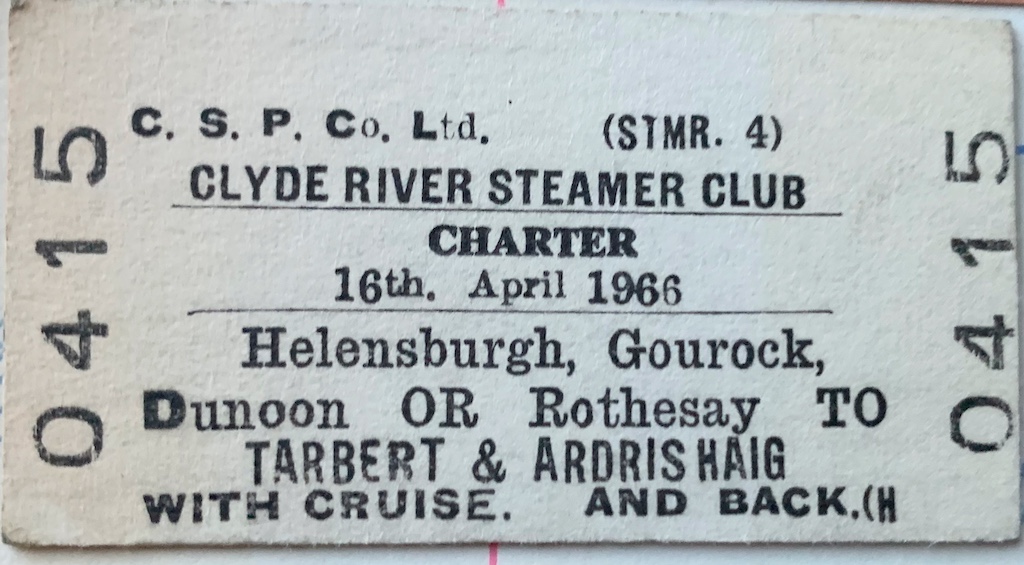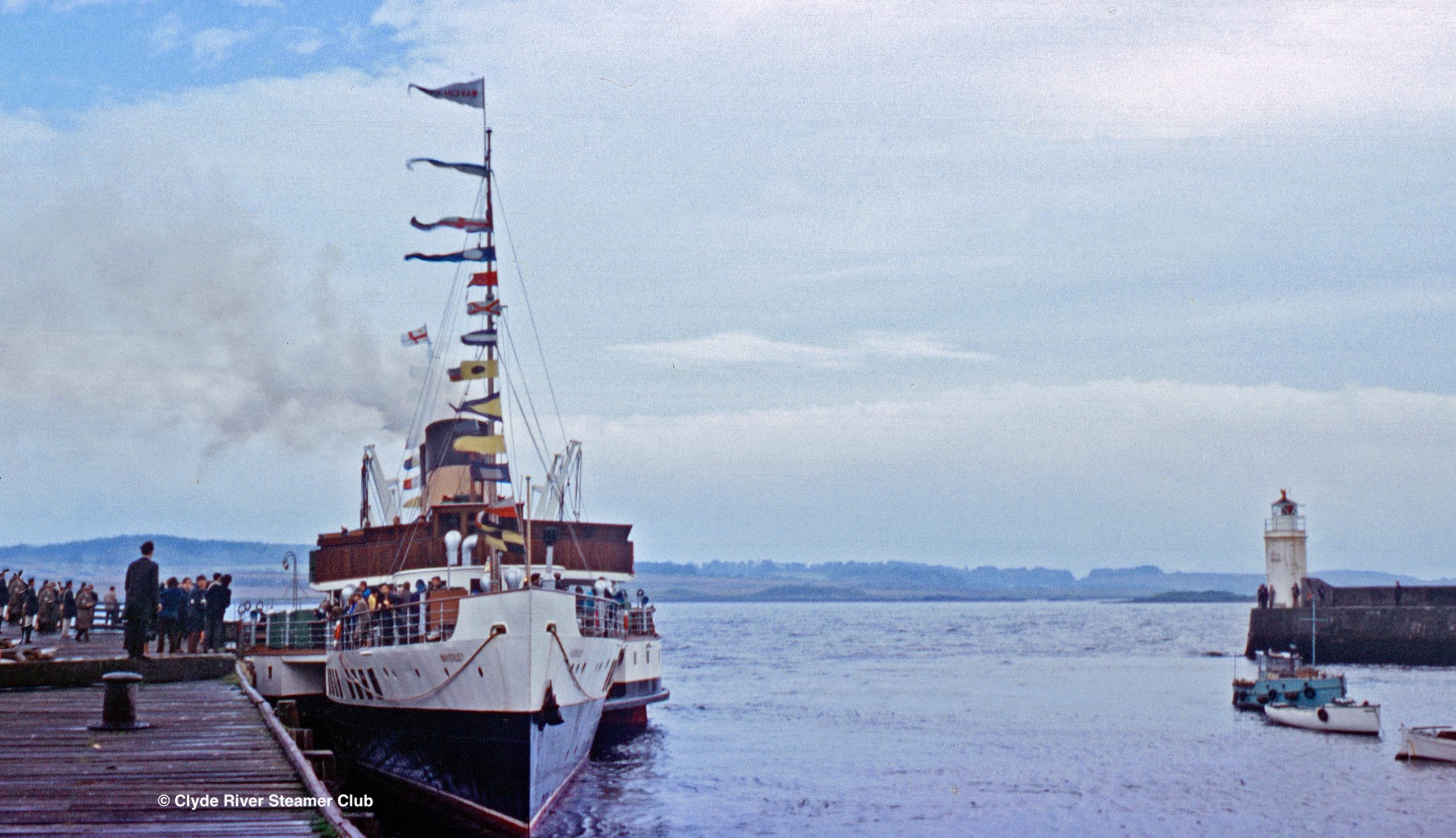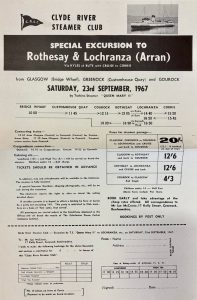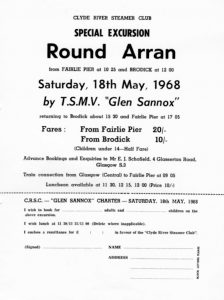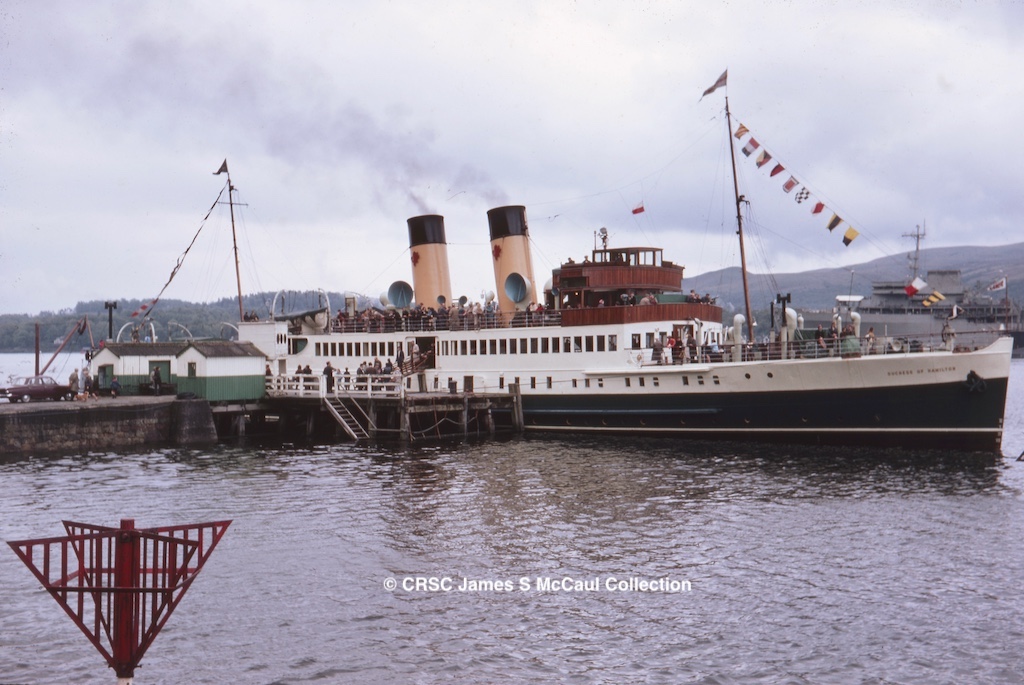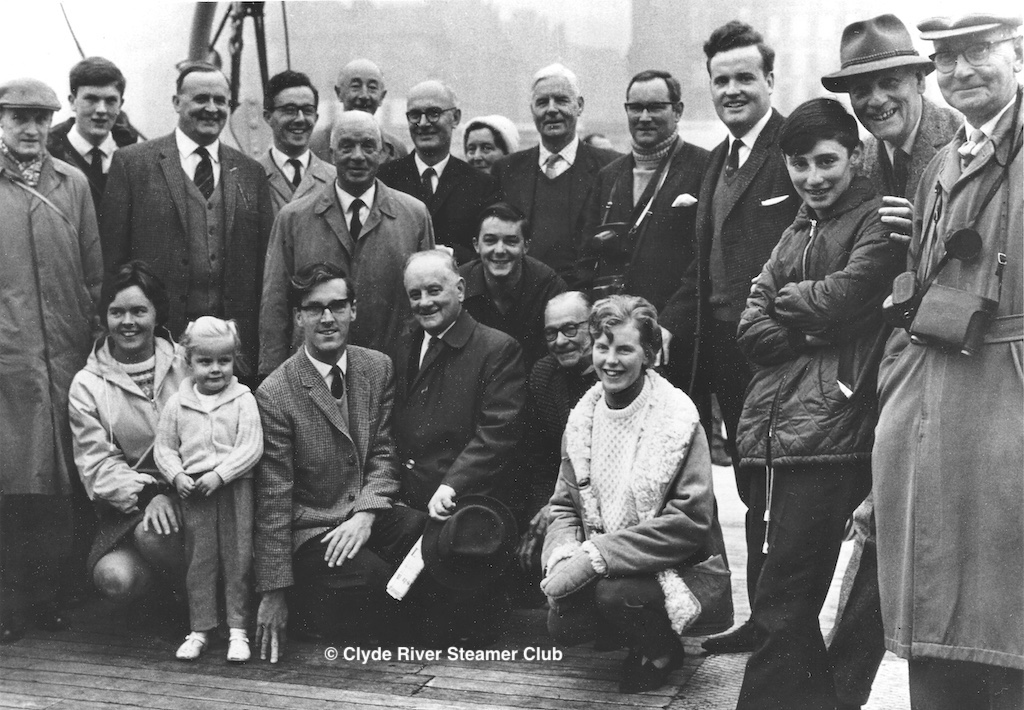
CRSC charter of Queen Mary II to Lochranza and Corrie on 23 September 1967: among the pivotal figures at that time were Iain MacArthur (standing fourth left), Douglas Brown (crouching third left), Robin Boyd (standing fifth right) and Ian McCrorie (fourth right). The young man crouching dead centre is Eric Schofield, who gave his first CRSC talk in February 1969 and joined the Club committee three months later. Over the following 50 years he and William Tomlinson (treasurer since 1966, not in picture) played an increasingly influential role in the Club, and they remain committee members to this day
The late 1960s were the most creative years in CRSC history. From 1965 to 1971 membership expanded exponentially, spurred by a series of imaginatively conceived ‘big ship’ charters, the setting up of a magazine, the expansion of the Review, the sale of specially printed Club postcards and the publication of a hardback volume celebrating the 80th anniversary of the Caledonian Steam Packet Company. The Clyde River Steamer Club suddenly became the forum for west coast enthusiasts of all ages and backgrounds — including an unparalleled intake of young people — who wanted to meet, sail and talk together.
This is the latest in a series of articles tracing the development of CRSC since it was founded in 1932.

For more than a decade after his year as president, Ian McCrorie (left, on a CRSC ‘Countess’ charter in May 1965 with wife Olive and Club curator David Morton) was a driving force behind the Club’s exponential growth: he organised a string of charters whose success took even the CSP’s management by surprise
The Club’s growth in the late 1960s was driven not by the older generation of enthusiasts, who had guided its fortunes since the 1930s, but by a group of young university graduates whose energy and imagination spurred the organisation towards new realms of activism and research. Ian McCrorie, president in 1965-66 and organiser of numerous ‘big ship’ charters over the following decade, was the charismatic driving force, but he could not have achieved what he did without Fraser MacHaffie (treasurer 1964-66), Iain MacArthur (convener of publications 1965-80) and Robin Boyd, an influential behind-the-scenes enabler.
Another pivotal player in the Club’s late 1960s development was Douglas Brown, scion of a distinguished Greenock shipbuilding company: he sustained the late 1950s CRSC tradition of ‘small ship’ charters, organised a landmark CRSC-sponsored exhibition of Clyde steamer artefacts in Glasgow, and developed a burgeoning trade in postcards, which became a hugely sought-after feature of Club meetings, charters and postal offerings.
MacArthur, McCrorie, MacHaffie, Boyd, Brown and a few others of their postwar generation not only gave older Club members a reason to pass on their knowledge of the past. This nucleus of hard-working individuals also inspired a new breed of youngsters with the joys of observing the shipping scene at first hand and learning about Clyde and Hebridean shipping traditions. CRSC became the medium by which a younger generation could express (and expand upon) their fascination for steamers and ferries. This led in 1968 to the addition of a third clause in the ‘Objects of the Club’ printed on the annual syllabus — ‘To undertake and encourage research into the history of British coastal shipping’.
Ironically, all these developments coincided with the years when steamer fleets that had given pleasure around the British Isles for more than a century — notably on the Thames, Solent, Bristol Channel, Mersey and Scotland’s west coast — were in free-fall, as one by one much-loved older ships fell under the axe of hard-nosed financial scrutiny. On the west of Scotland this meant the withdrawal of Talisman (1966), Caledonia and Lochfyne (1969), and Duchess of Hamilton, Lochiel and Lochnevis (1970). Throughout the 1960s not a single new-build joined the Clyde fleet. And yet CRSC thrived beyond anyone’s expectations.
●
The launch of ‘Clyde Steamers’ in 1965 was the first visible sign of the impact that ‘the Messrs Mac’ — Iain MacArthur, Ian McCrorie and Fraser MacHaffie — were having on the Club. Thanks to practical help from Robin Boyd and contributions from a core of members (including Douglas Brown, who penned a series on Scottish inland loch steamers), the annual magazine quickly established itself as a ‘must have’ publication for ship lovers.
After initially being printed by an offset litho process with variable picture quality, ‘Clyde Steamers’ became foolscap-size in 1969, and from 1970 it was professionally printed with proper illustrations. Many older members today have nostalgic memories of the moment when, each year, the latest edition would drop through the letterbox at home, prompting a surge of barely containable excitement as page upon page was devoured. Over the following days, weeks and, yes, months, contents and illustrations would be repeatedly re-examined and minutely pored over.
In 1966 the appearance of a properly printed Review created no less a sense of a world of information and detail being opened up that had scarcely been dreamt of. The Review quickly established itself as an invaluable historical record of west coast shipping movements, as useful to the casual enthusiast as to researchers and professional mariners.
Iain MacArthur, a full-time school teacher who spent half of each year on the magazine before devoting the rest of the year to the Review, recently recalled that “it was all very home-made. A lot of work went into the gathering, planning and designing of those publications, but there was also a lot enjoyment.”
Fraser MacHaffie says he always saw himself as “the junior partner, who was handy with typing and admin. I typed the early Reviews and magazines. The ‘Messrs Mac’ seldom met as a group outside of CRSC meetings. Occasionally Iain MacArthur would come up to Glasgow and we would meet to discuss layout and changes to text, but most was done by phone.” Fraser gave up the post of treasurer when he left Glasgow for London in 1966, but remained an important contributor to CRSC publications.
Paid-up CRSC members can examine annual Reviews from the late 1960s by clicking here.
●

The book to which CRSC devoted so much energy in the late 1960s became Iain MacArthur’s greatest achievement. It is still sought-after today
It was a sign of the ambition of CRSC’s ‘young Turks’ that they should seek to build upon the success of the Club’s two annual publications by producing a substantial volume chronicling the history of the Caledonian Steam Packet Company, the 80th anniversary of which came in 1969.
In 1965 the Club had helped to publicise the centenary of steamship services from Wemyss Bay, and in 1966 it celebrated the centenary of the North British Railway’s Clyde steamer services by chartering Waverley for a sailing from Helensburgh to Ardrishaig. The 1969 CSP anniversary seemed a logical next step, and a charter of Duchess of Hamilton gave the anniversary ample publicity. But such was the work involved in writing and producing The Caledonian Steam Packet Co Ltd, an illustrated history by Iain MacArthur, that the 290-page hardback did not appear until 1971.
Various senior Club members contributed to the body of the text. Ian McCrorie helped complete the end sections and Robin Boyd drew the maps. Fraser MacHaffie typed the appendices, compiled the Index and did the publicity.
“Once we had decided on a book and the title,” says Iain MacArthur, “I had to get somebody to publish it. Nobody was interested. Eventually Leslie Stephenson [owner of T. Stephenson & Sons, a printing company in Prescot, Lancashire] agreed to print it, and he was very helpful and generous. But that still left the Club with the job of publishing and distributing it.”
Iain and his collaborators knew that funding a book of this size would be a problem for an association of amateur enthusiasts, but a handful of Club members gave a surety of £500 each, and the Club offered a price reduction to anyone who pre-booked their copy. “When we had to raise the published price [to £4.50!] to defray the cost, some who hadn’t pre-booked were very annoyed. Once we received the printed copies, Graham Langmuir, Robin Boyd and Marshall Walker took a lot of them into home storage, and I had help from my family in despatching them to buyers. By the mid 1970s we’d wrapped it all up — the book had washed its face.”
●
Building on the experience of putting together an exhibition in Greenock in 1962 to mark the 150th anniversary of Comet, Douglas Brown led the Club’s promotion of a large-scale exhibition of steamer memorabilia at the Kelvingrove Art Galleries in 1969. Sponsored by the City of Glasgow, ‘Steamers of the Clyde’ pulled in thousands of visitors and was a huge success, helping to raise public awareness of and stimulate pride in Clydeside’s steamer heritage.
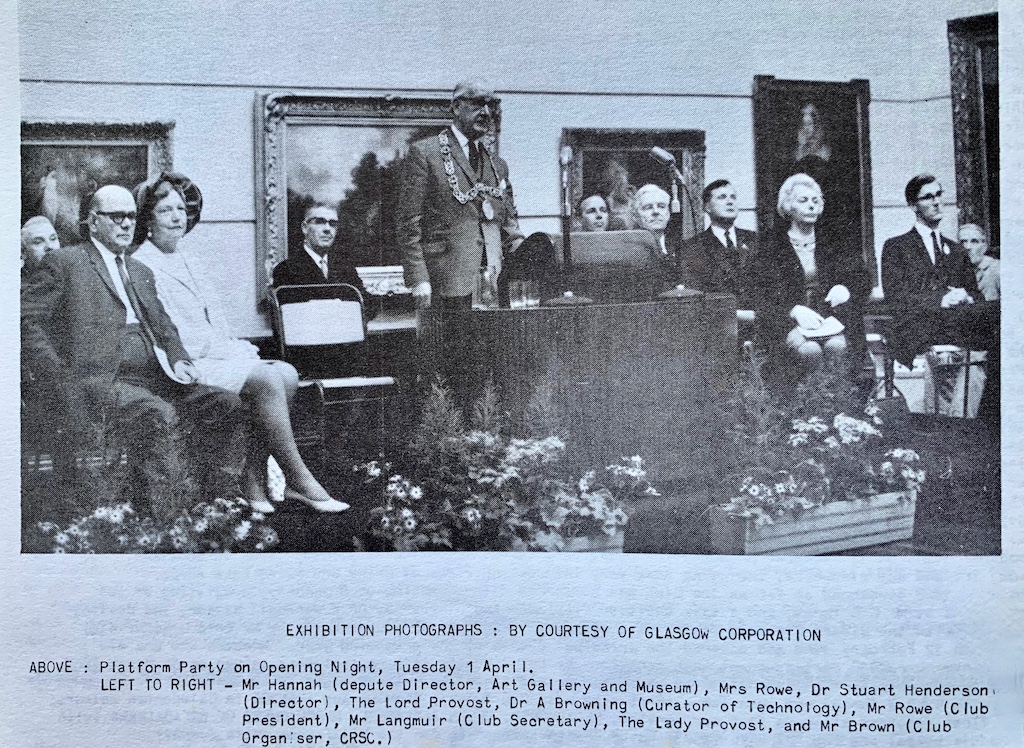
Opening ceremony of the landmark ‘Steamers of the Clyde’ exhibition on 1 April 1969, with Douglas Brown seated on the far right, Graham Langmuir third right and Club president Dick Rowe fourth right
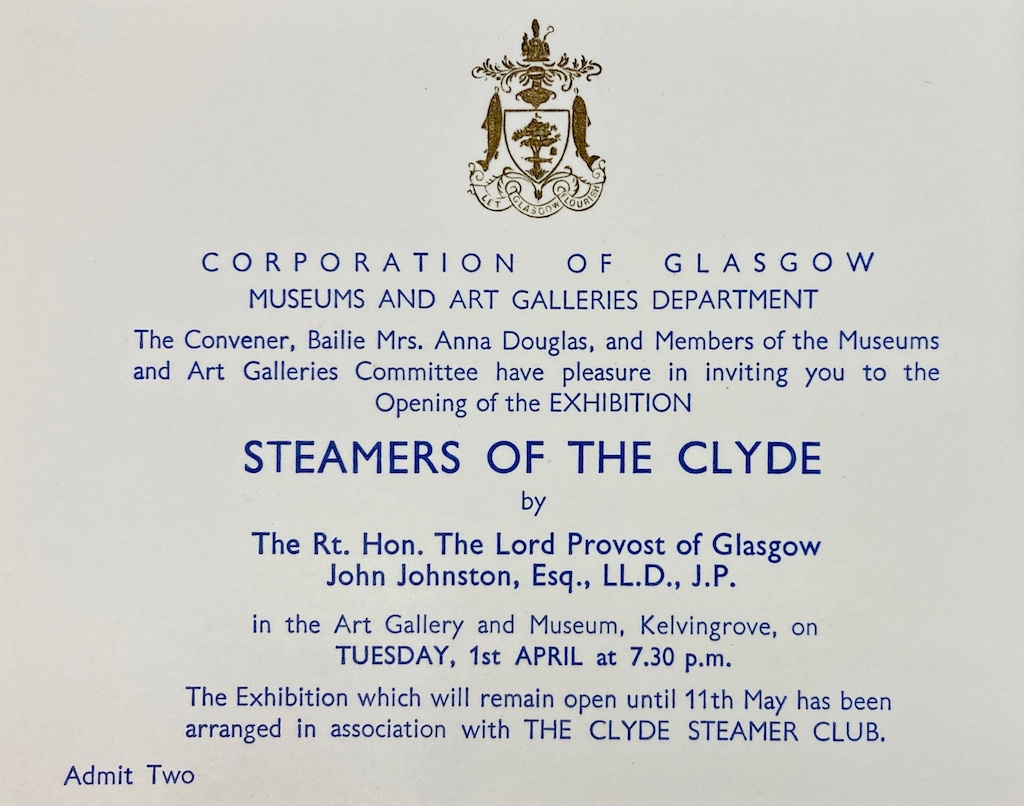
Invitation card to the opening ceremony. Douglas Brown put in a huge amount of work to make the exhibition a success
●
The most visible sign of CRSC’s development in the late 1960s was the series of charters organised by Ian McCrorie (who also wrote the text for the brochures that accompanied each sailing). Their scale and ambition, unprecedented at the time but a marker for others to follow, was breathtaking, and their impact went deep into the psyche of huge numbers of enthusiasts. They brought in dozens of new members and embraced a wide public.
The first of these charters took place on 16 April 1966, when Waverley traced the North British Railway’s original 1866 steamer route from the north bank of the Clyde to Tarbert and Ardrishaig. It was a chilly day but the atmosphere on board warmed the hearts of the hundreds who took part.
●
Another trailblazer was the CRSC charter of Maid of Argyll from Paisley Harbour in September 1966. The excursion started at Gourock, and after sailing up the River Cart and berthing in the harbour, Maid of Argyll returned down-river for a cruise to Loch Striven and back to Gourock.

Maid of Argyll’s visit to Paisley Harbour on 17 September 1966 was the first Clyde steamer trip up the River Cart for decades — and came shortly before Paisley Corporation announced its intention to close the harbour and the River Cart to commercial sailings
Smaller-scale CRSC charters continued with excursions on Countess of Breadalbane to Ardentinny in May 1965 and Kames in May 1966, and on Gourockian ex Ashton to Port Bannatyne in August 1969. In between these adventurous excursions came a different type of sociable gathering — the Club’s 35th anniversary, marked by a special dinner in the Ca’doro restaurant on 26 April 1967.

When Countess of Breadalbane visited Ardentinny in Loch Long on a CRSC charter on 22 May 1965, she revived the ferry call that Arrochar-bound steamers had last made there in the late 1930s
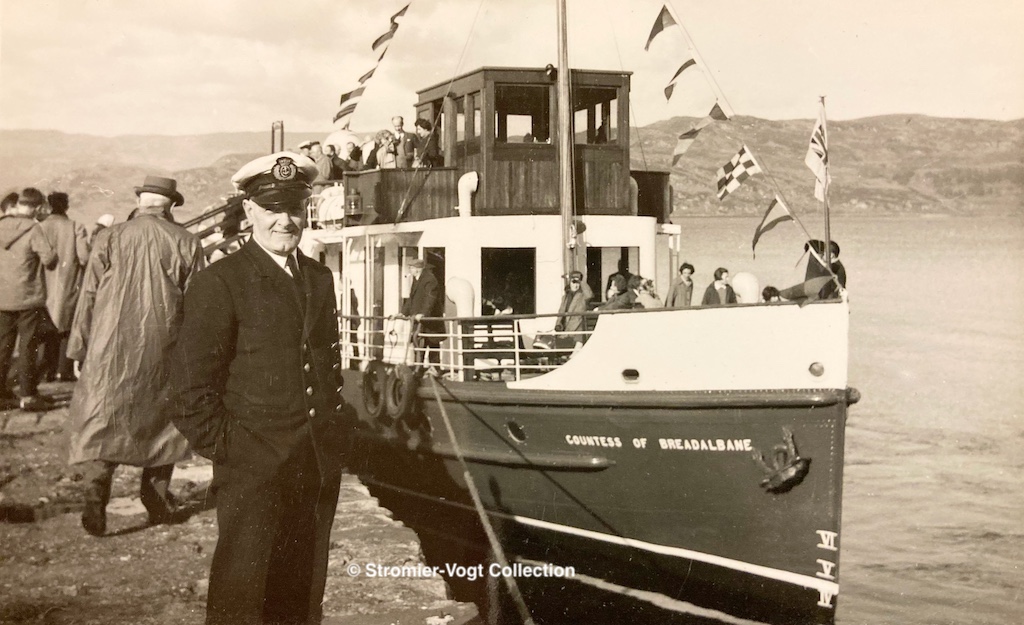
Donald Robison, motorman of Countess of Breadalbane, poses for the camera on the ‘gunpowder pier’ at Kames on 14 May 1966

Front of menu card for CRSC’s 35th anniversary dinner, which was attended by all the leading lights of the Club. Click on image to enlarge

Many of those present signed the menu card — notably Captain Fergus Murdoch of Duchess of Hamilton (and his wife Agnes). Click on image to enlarge
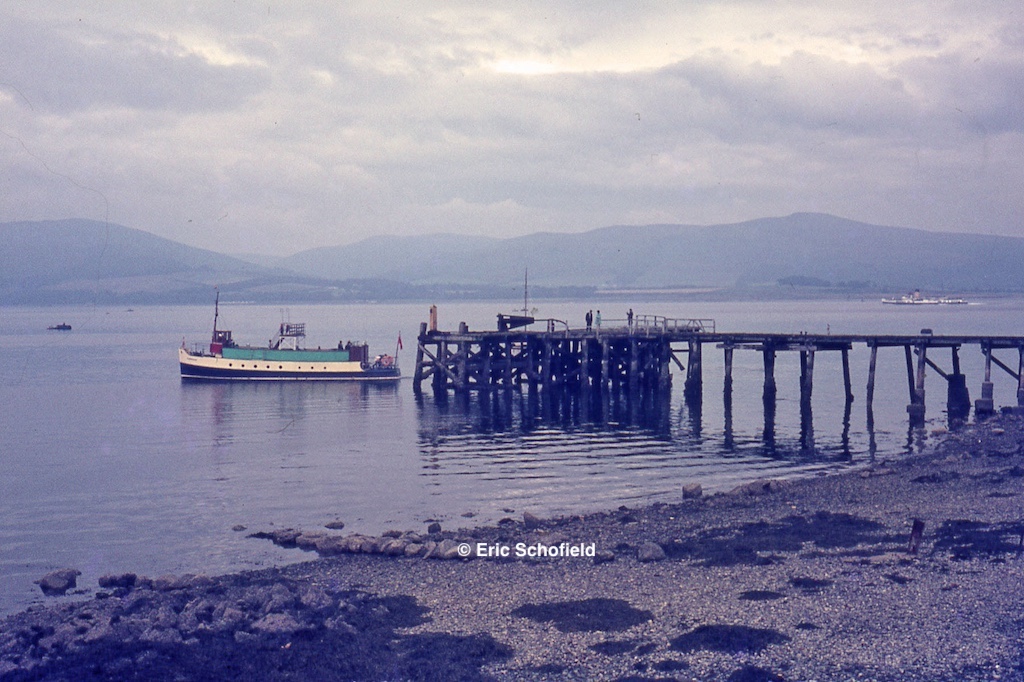
Gourockian ex Ashton at Port Bannatyne on a CRSC charter on 9 August 1969, with Caledonia heading for the Kyles in the background
●
But it was the boundless ambition of CRSC’s ‘big ship’ charters that really captured the imagination, as Ian McCrorie sought to take advantage of the early- and late-season availability of the dwindling number of Clyde steamers in the late 1960s. Among the most notable were Duchess of Hamilton’s visit to Girvan in 1967 (the first Clyde steamer call there since pre-war days), and to Troon and Arrochar in 1968; Queen Mary II’s excursion from Bridge Wharf to Corrie in 1967, reviving a pre-war ferry call; and Caledonia’s cruises to Inveraray and the head of Loch Fyne (1968) and Campbeltown (1969).
The biggest triumph of all was the charter of the ‘Hamilton’ from Glasgow to Gourock, Kilmun, Brodick and Ardrossan’s Montgomerie Pier on 31 May 1969, marking the Caledonian Steam Packet Company’s 80th anniversary. While the ship was berthed at Gourock, the newly installed Scottish Transport Group’s top brass took part in a ceremony in which they made a gift to the Club of the builder’s half-model of Duchess of Hamilton’s 1890 predecessor (now on permanent loan to The Isle of Arran Heritage Museum, Brodick).
CRSC also embraced the diesel age with charters of Glen Sannox round Arran in May 1968 and through the Kyles of Bute in April 1969.
Thinking back to those days, Fraser MacHaffie says “It was a big risk to move beyond the ‘Breadalbane’ on the charter front, since the Club was dominated by ‘stay home’ folks who met once a month to reminisce. It was the general public that carried us through.”

Duchess of Hamilton at Girvan during a CRSC charter on 29 April 1967 — her first visit there since the 1930s
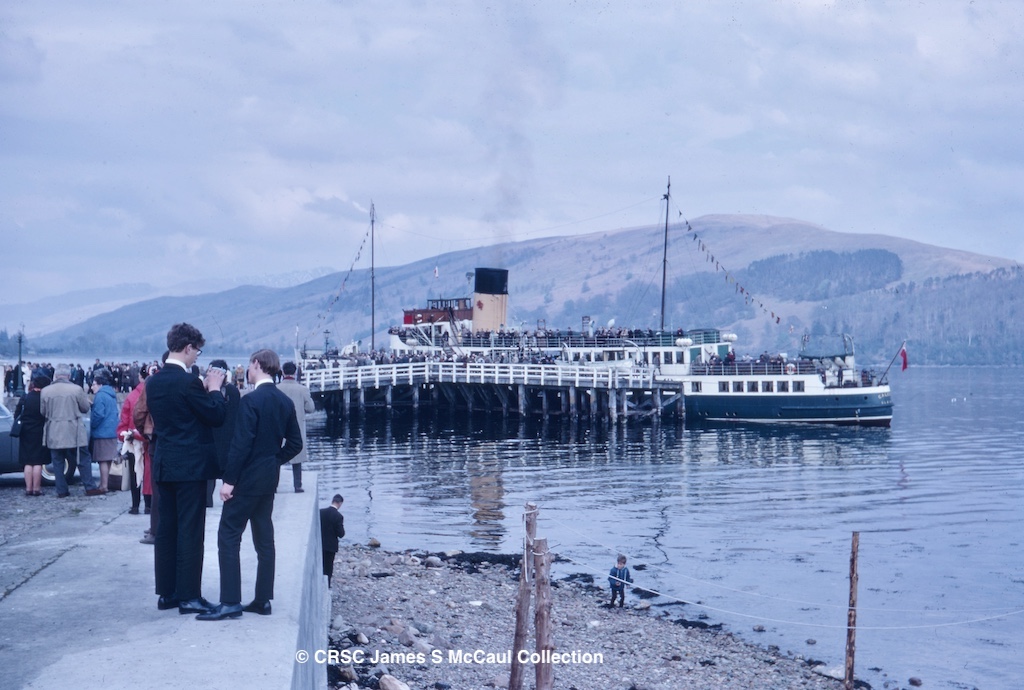
Caledonia at Inveraray on the CRSC charter of 4 May 1968: after giving excursionists a photograph stop, she sailed to the head of Loch Fyne, turning at Dunderave – the only time in living memory that a Clyde steamer had ventured to the head of the loch

Glen Sannox at Brodick on 18 May 1968, dressed overall for CRSC’s Round Arran cruise — our first charter of a car ferry
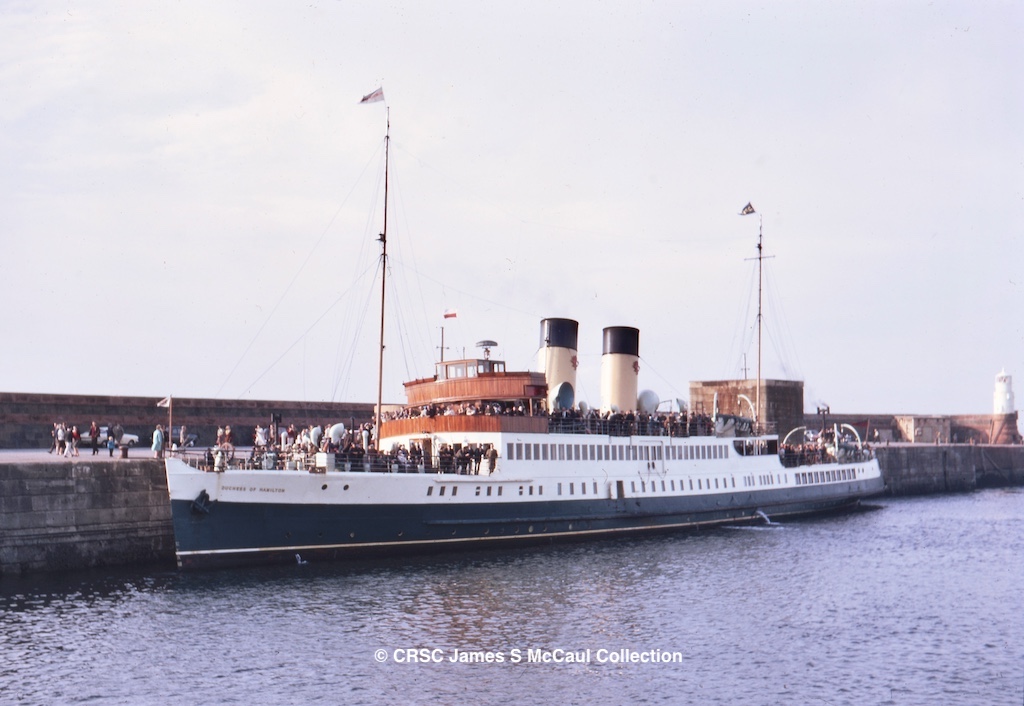
Duchess of Hamilton at Troon on the CRSC charter of 7 September 1968, when she retraced the cruise to Arrochar that had been a regular feature of her 1930s summers as Ayr excursion steamer
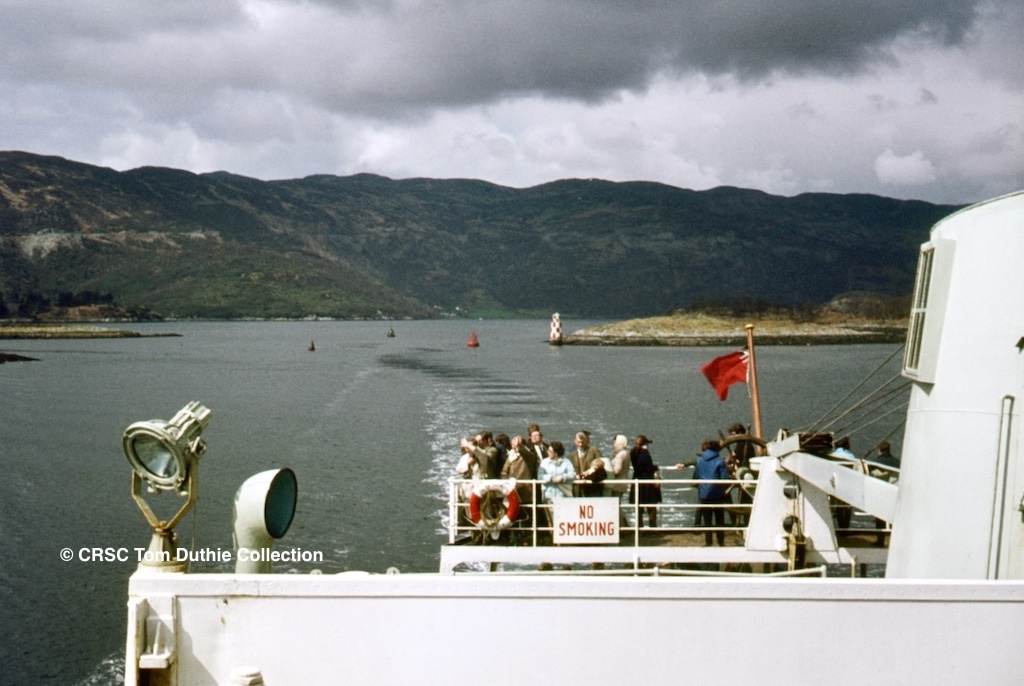
View of the Narrows from the aft deck of Glen Sannox during her first sail through the Kyles of Bute, on the CRSC charter of 26 April 1969
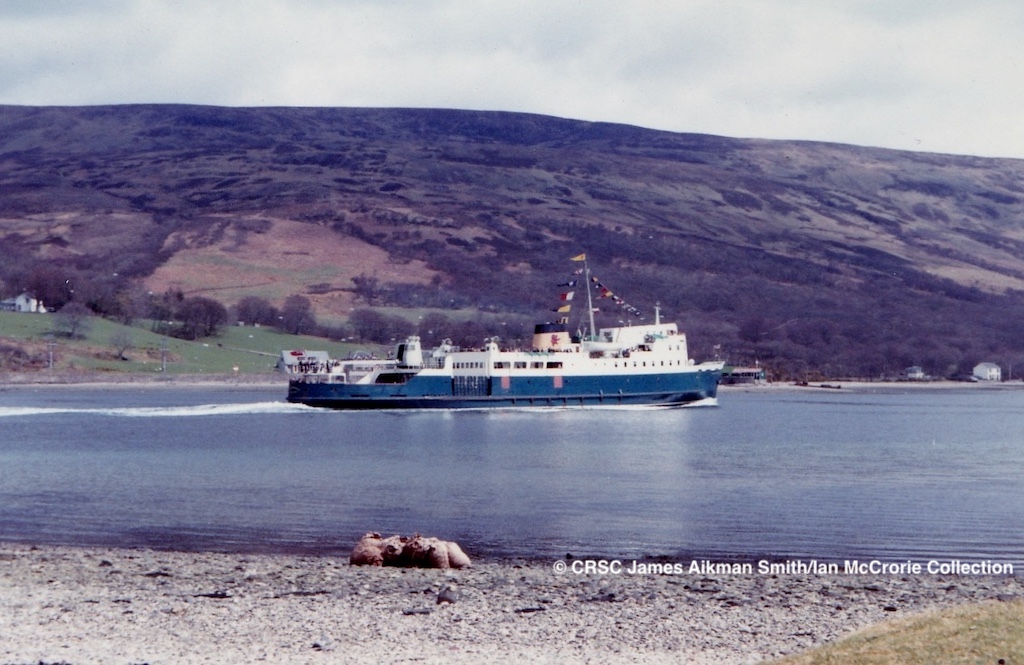
Like CRSC’s Round Arran charter of Glen Sannox in 1968, the Round Bute charter of 26 April 1969 indicated that the Club had made a psychological leap, recognising that the new breed of diesel ferries were no longer to be shunned, but rather embraced as a foretaste of the future. Glen Sannox is pictured from the Bute shore, passing Colintraive on her way down the East Kyle. The ‘Sannox’ became a regular ‘charter steamer’ for the Club in the 1970s and 80s
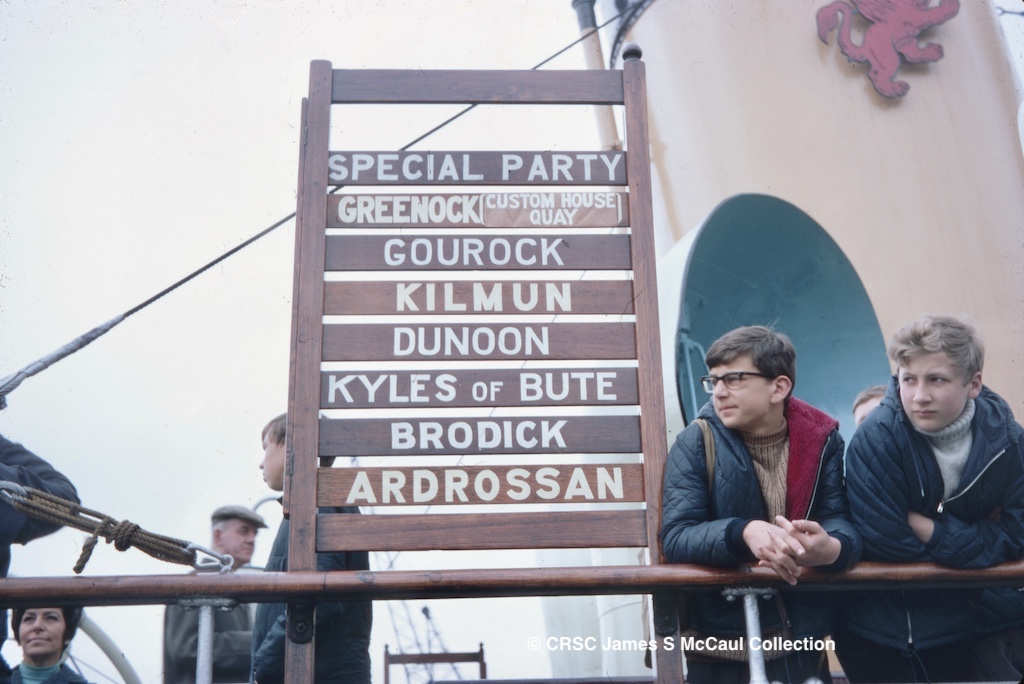
Duchess of Hamilton’s destination board on 31 May 1969, pictured from the dockside in Glasgow before departure on what turned out to be an epic day for CRSC excursionists
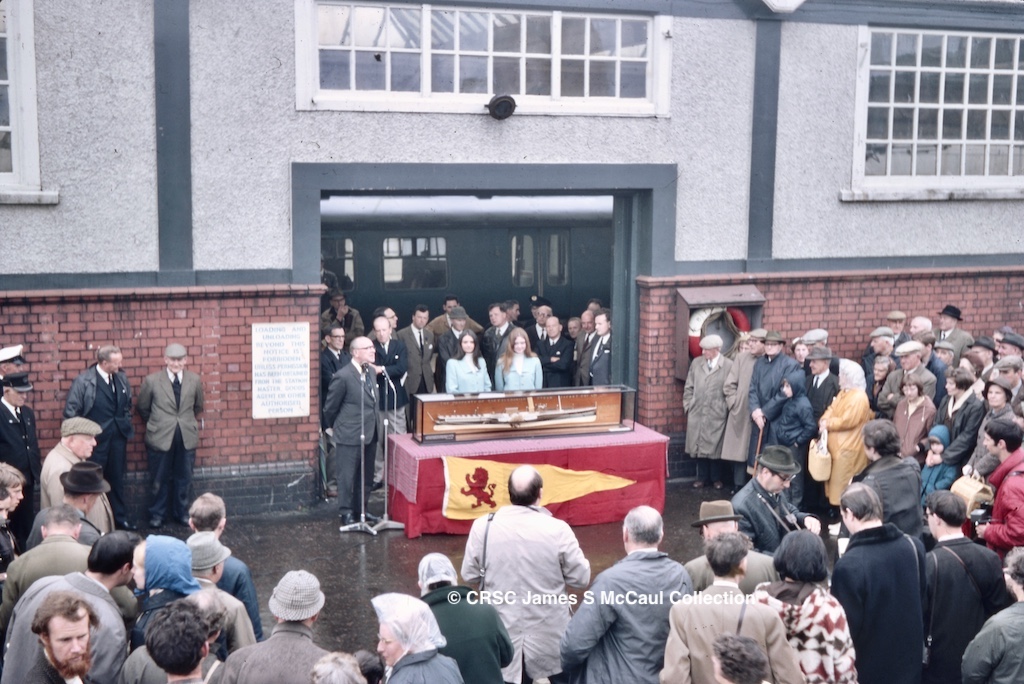
View from the top deck of Duchess of Hamilton at Gourock Pier on 31 May 1969, during a ceremony marking the Caledonian Steam Packet Company’s 80th anniversary and the handover of a half-model of the steamer’s 1890 predecessor to CRSC officials, including Ian McCrorie (far right of official party) and Graham Langmuir (between the two hostesses). The speaker on the left is Moris Little, the Scottish Transport Group’s managing director
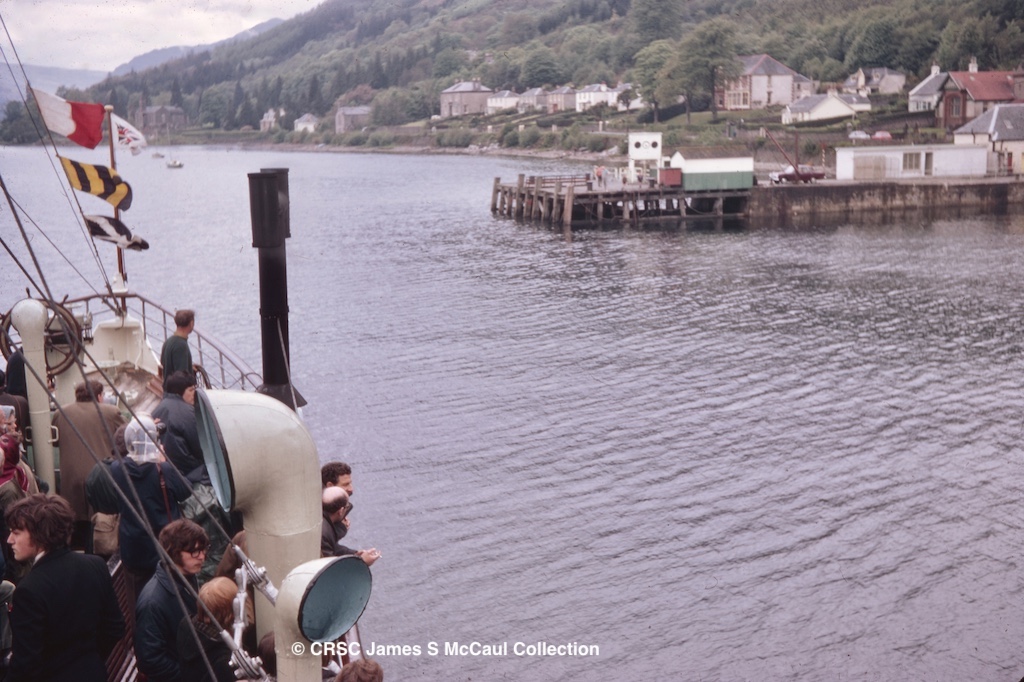
En route from Gourock to Brodick on 31 May 1969, the ‘Hamilton’ made an unusual call at Kilmun, the last operational Holy Loch pier, which was to close two years later (though it later became a Western Ferries lie-over base). The village is viewed from the steamer’s top deck as she approached the pier. Kilmun had played a significant role in the emergence of the Gourock-based Caledonian Steam Packet Company 80 years earlier, when the Campbells of Kilmun sold out to the new railway-backed steamer operator, handing over their remaining fleet to Gourock’s control
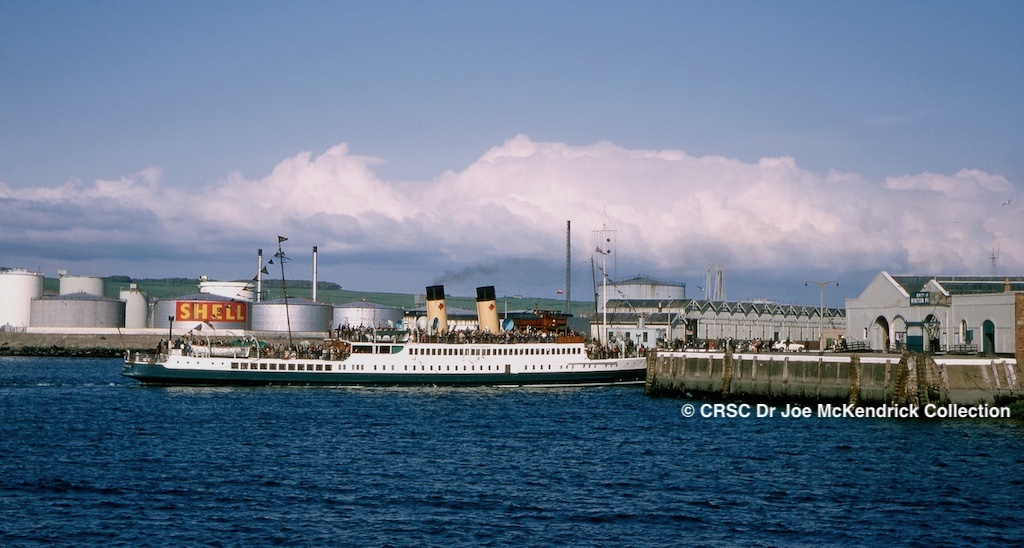
The climax to the day’s itinerary was a call at Montgomerie Pier, Ardrossan, where the CSP made its mark on the Arran run in 1889

After berthing alongside the old Caledonian Railway terminus in Ardrossan’s inner harbour, Duchess of Hamilton was photographed by all and sundry
CRSC ended the 1960s with a memorable charter of Caledonia to Campbeltown on 13 September 1969. By that time it was known that she would be withdrawn at the end of the season, giving the sailing — in glorious early autumn sunshine — a valedictory air.
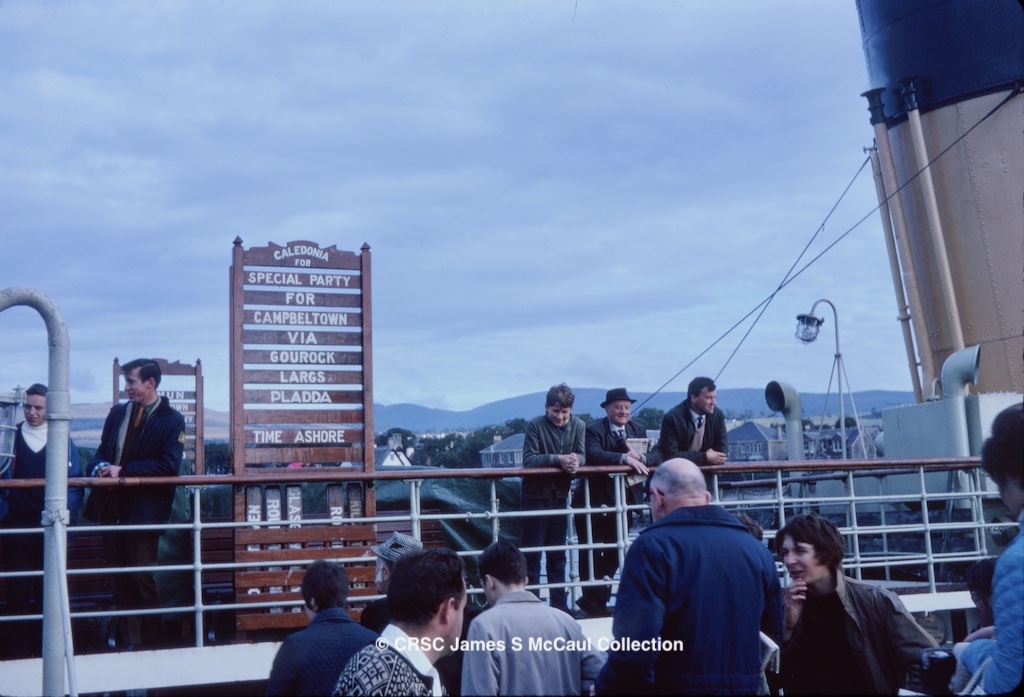
Caledonia’s destination board at Craigendoran on the morning of 13 September 1969, when she was chartered by CRSC to sail to Campbeltown — outward via Pladda and returning via Lochranza and the Kyles of Bute

Ian McCrorie was a great communicator and organiser: he underlined the significance of the Caledonia charter in a letter posted well in advance to all CRSC members. Click on image to enlarge

The charter prospectus was a typical McCrorie masterpiece: tickets were eagerly snapped up by enthusiasts. Click on image to enlarge
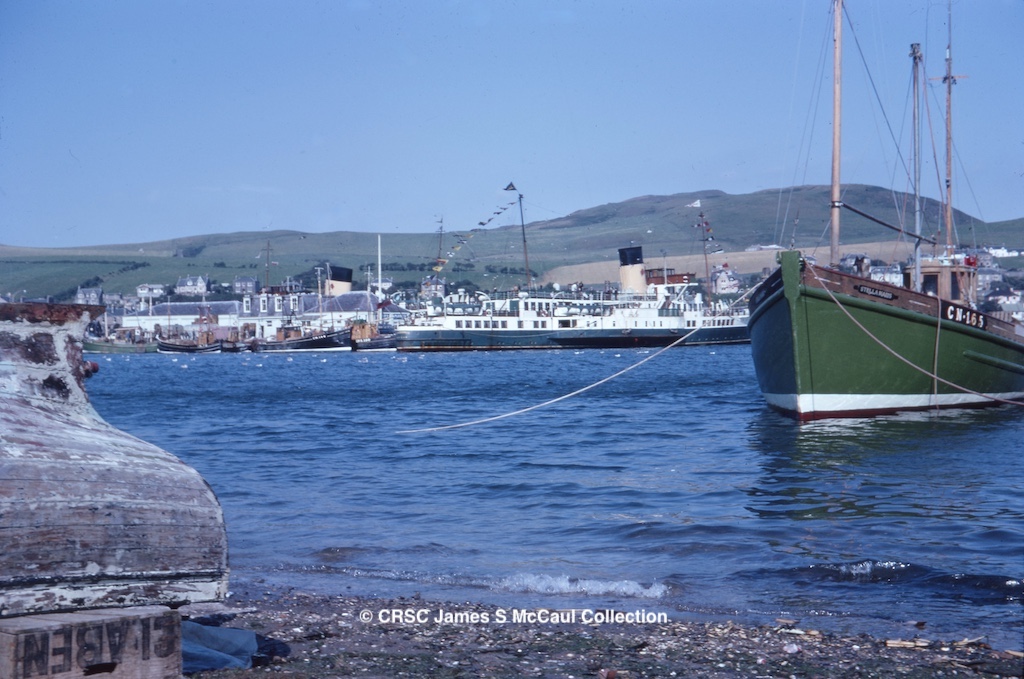
During Caledonia’s visit to Campbeltown on charter to CRSC on 13 September 1969, she was joined by Queen Mary II , which gave the regular service run from Gourock. The sight of the two steamers together at the Kintyre port made for a poignant — and memorable — end to the 1960s era of Club cruising
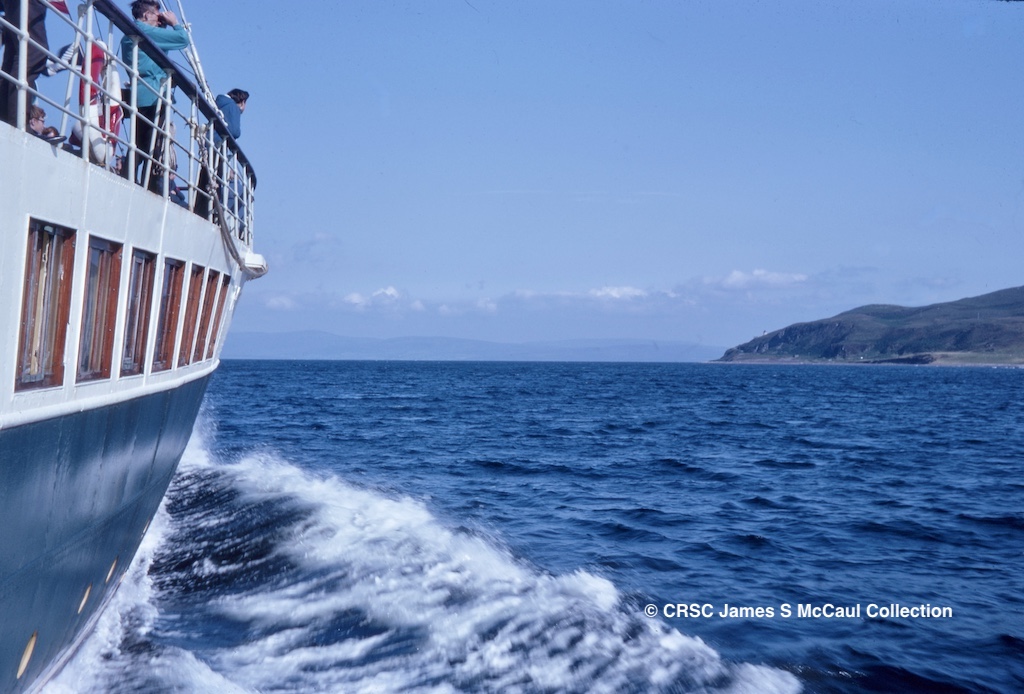
Farewell to Campbeltown Loch: view from the starboard sponson as Caledonia headed back to Gourock on her final CRSC charter, three weeks before she was withdrawn from Clyde service
Compiled by Andrew Clark, with thanks to Iain MacArthur, Fraser MacHaffie, Douglas Brown and Fiona Stromier.
●
SEE ALSO:
CRSC in the early 60s: springboard to rejuvenation
Stromier & Vogt, Co-Creators of a Club Culture (members only)
CRSC Reviews 1965-69 (paid-up CRSC members only)
●
CRSC is an association of friendly enthusiasts united by the quest to ‘meet together, sail together and talk together’, mainly on the west of Scotland — but many members hail from further afield. If you join us, you’ll receive copies of our much-prized west coast shipping Review and annual magazine, as well as access to a huge library of archive photos in the ‘Members Only’ section of this website. We gather for meetings and cruises throughout the year. To join us, click here.
Published on 27 January 2024












